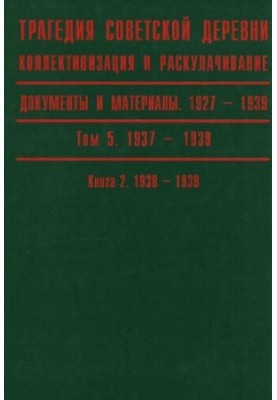The Tragedy of the Soviet Village. Collectivization and Dekulakization. 1927-1939. In 5 vol. 5. Book 2. 1938-1939
 Instant download
Instant download
after payment (24/7)
 Wide range of formats
Wide range of formats
(for all gadgets)
 Full book
Full book
(including for Apple and Android)
The Tragedy of the Soviet Village . Collectivization and dekulakization. 1927-1939. In 5 t. T. 5. Kn. 2. 1938-1939 "is a deep and comprehensive study of one of the most dramatic and pivotal periods in the history of the Soviet Union. The author, whose name remains unknown, created a large-scale work revealing the tragic pages of collectivization and dekulakization, which radically changed the fate of millions of people and the fate of the Soviet village in the pre-war years. This book is not just a historical work, but a living testimony to an era saturated with details, archival documents and personal stories. In it, the author masterfully immerses the reader in the atmosphere of 1938-1939, revealing the complex processes that took place in rural areas of the country. The focus is on the fate of those who were on the verge of destruction or had to fight for survival in the conditions of strict state policy. The reader will learn about large-scale dekulakization operations, about those who lost everything - homes, property, loved ones - and about people who tried to maintain dignity and faith in the future despite the horrors of repression. The Tragedy of the Soviet Village . Collectivization and dekulakization. 1927-1939" is intended for a wide audience - from students and historians to those who are interested in the fate of the Soviet era and the history of the country. It will be especially interesting for readers who are passionate about Soviet politics, social transformations, the history of the peasantry and repressions. This work is suitable for those who are looking for a deep understanding of the causes and consequences of large-scale social upheavals, and also want to look at history through the prism of human fate. An author with a rich knowledge of archival materials and historical analytics creates a vivid and rich narrative in which each page is filled with meaning and emotions. His style is a combination of scientific rigor and a lively, emotional narrative that makes reading not only informative, but also exciting. Unlike many works on the history of the Soviet era, this book is not limited to dry facts, but reveals the inner world of the heroes, their fears, hopes and despair. Of particular importance is the fact that the author raises important topics - from the destruction of traditional peasant lifestyles to the formation of a new Soviet man, from the struggle for survival to the moral dilemmas faced by people in those years. The book emphasizes that behind the statistics and figures are real destinies, and the tragedy of the village is not only a historical fact, but a human drama that has remained in the memory of generations. If you are interested in the history of the USSR, social policy, repression or just want to understand how the Soviet village was formed in the pre-war years, this book will become a valuable source of knowledge and reflection for you. It will help to look at the events of 1938-1939 not only through the prism of official documents, but also through personal stories, which makes it especially significant and relevant. The Tragedy of the Soviet Village . Collectivization and dekulakization. 1927-1939 "is not only a historical work, but also an important reminder of what tragedies can arise when power loses contact with the people and forgets about human dignity. This book deserves a place in the hearts of those who appreciate an honest and in-depth study of the past, because understanding history helps us better understand the present and build the future.
LF/654698588/R
Data sheet
- Name of the Author
- Unknown
- Language
- Russian
- ISBN
- 9785824305401
- Release date
- 2004
- Volume
- 5 / 2



















